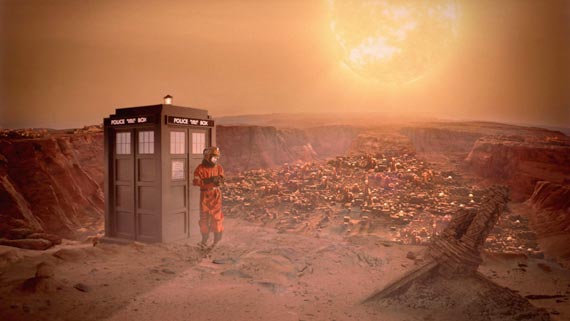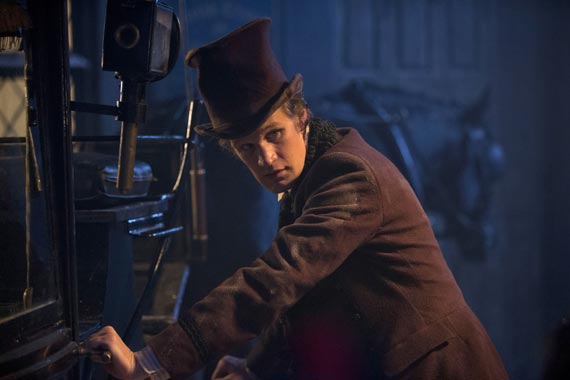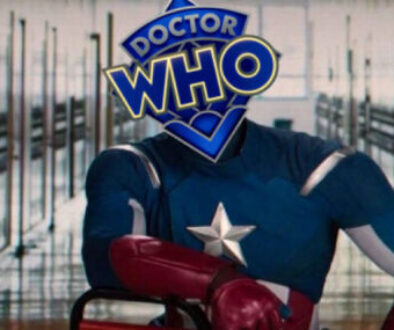Series 7: We’re all ghosts to you
Guest contributor Sylvie Lassiaille examines the themes of Series 7.

There’s a lot you can say on Steven Moffat—praise or criticize him, one thing that cannot be denied is that he is ambitious. And that he knows his literature. But what else can we expect of an English Major?
Steven Moffat has often added layers and layers of symbolism and metaphors during his run of the show, but few people have noticed them. Series 5’s major theme was the one of stories and fairytales; Series 6’s was rather about reflections, both on a symbolic level and a literal level. While one can criticize his show running skills and writing, I do think Moffat certainly deserves his English Major. The overarching themes in his run are intricate and subtle, and they add a lot to the show for a literature fan like me. I might not be a literature Major myself, but so much symbolism is appreciated.
So let us talk of Series 7’s literary meaning— not about the acting or plot or what it means for the anniversary, but rather about its overarching themes. Steven Moffat loves overarching themes. Series 5 was about stories and fairytales and how they affect us: Amy’s childhood and seeing the Doctor as an imaginary friend, all the fairy tale elements, not to mention how Amy brings back the Doctor thanks to a story in her head. Series 6’s main theme was reflections, on both a metaphorical and literal level: the doubles (The Tesselecta, the Flesh, Amy’s older self), the mirrors and reflections everywhere during the series, and the Doctor being confronted to who he is (good sides and bad sides), as if he were gazing in a mirror.
But this season’s theme is rather interesting as well, and just as “We’re all stories in the end” sums up Series 5, Hide offers us the quote that sums up this season:
“We’re all ghosts to you.”

Series 7 is all about ghosts—specifically those who haunt the Doctor, and how he clings to these echoes. It is also about the Doctor having to confront these ghosts in order to evolve. And oh, is it well done.
The series starts with the Doctor as a ghost, since he is supposed to be dead or at least the galaxy thinks so. He has been erasing himself from history, falling back into the shadows— becoming no-more than the faded ‘dark legend’ that we’ve heard of in Series 6. Yet he is not a ghost to all yet; The Daleks find him and capture him, bringing face to face with that dark legend (as the Predator). Thus does the Doctor face the first of his ghosts: his own reputation.
It’s telling that he is sent to the Asylum. What we see of the planet seems to enforce that theme of ghosts: The Asylum is a wreck, with half-dead Daleks and converted humans haunting its corridors. These same humans are turned into echoes themselves— dead yet still living past their time. Amy almost joins them, and the scene in which she hallucinates is interesting in itself: who is it that she sees? Ghosts from the past, how the Daleks see themselves?
But another ghost is present, and she is a literal ghost in the machine in several ways: our first meeting with Clara presents us with two echoes in one. The first is Clara’s split echo from the finale as Oswin Oswald. Oswin herself is an echo as well: her ghost haunts the shell of a Dalek, clinging to her humanity and refusing to let go long after her death. And when she is forced to confront the reality of her situation, that ghost is almost destroyed. And yet she manages to hold on to her humanity, proving herself as more than a ghost. Oswin is dead, but she fights and will live on in the Doctor’s memory.
Put another way: Oswin, a ghost on already two levels, becomes a ghost on a third level by starting to haunt him. Furthermore, the Doctor becomes closer to a ghost by being erased from the Daleks’ memory.

A Town Called Mercy brings back the theme of ghosts, though these times they are symbolic rather than physically present. Kahler Jex is haunted by those he has killed and made suffer in the past, and is fully aware that one day he will have to face them. In perspective, this is delicious foreshadowing—we know that the Doctor, who has been presented several times as a parallel to Jex, will eventually have to face his own ghosts. Whithouse has done a fine job presenting a second comparison to our protagonist, as opposed to the Minotaur in his Series 6 episode, The God Complex.
Let’s move on to the next episodes: The Power of Three is a foil to these previous episodes. Rather than seeing ghosts, we see people who are decidedly very alive. Amy and Rory are both very much human and anything but echoes in this episode, which makes the following one very much significant. The Angels Take Manhattan ends in a graveyard—both for the plot’s purpose but also in symbolic tones: Amy and Rory might have lived a very long and happy life, but their grave is here, marking them as the Doctor’s new ghosts. We know many of his companions still haunt him—but now we see direct proof of that. Rory and Amy do not die directly in front of the audience’s (and the Doctor’s) eyes: they fade away, like echoes lost in time. And as the Doctor ends the episode by putting on Amy’s glasses, we know that they will haunt him for a long, long time.
And at this point it’s time to introduce a new ghost, or rather an old one: it’s significant that by the time of The Snowmen, we see Clara living several lives in more ways than one. It’s not simply her different reincarnations—Victorian Clara is both a governess with an educated tone and a firm grip on the household and a knowing cockney waitress in a tavern downtown. Two very different lives— it’s a as though even as a single echo she is split in several ghosts, with each of their mannerisms. (Side note: seeing the finale, the Doctor has also been split apart. Is there a correlation here?)

Meanwhile, the Doctor is haunted by the loss of his beloved Ponds (who were, in many ways, his family) and acts very much like a ghost himself. Yet the story repeats itself again. The Doctor has been, for the past two seasons, a fairy tale. To Amy, to River (when raised by the Silence), to the girl in A Good Man Goes To War, and to children all across the universe. By the time he is in Victorian London, he has very much reached his goal of disappearing entirely. And here the cycle starts again: Clara tells the children a bedtime story about the Doctor, making this the first step to rebuild his reputation and bring him out of the shadows. She also alights his curiosity again and convinces him to save Earth and take her as a companion—and thus the show’s cycle has started again.
This Clara dies, and we are once again in a graveyard, only this time the reaction to the grave isn’t grief—it’s joy. Amy and Rory’s death and subsequent haunting have been hurting him—but the confirmation that Clara has died twice gives him the hope that he will find a companion who will stay alive—one who will not remain a ghost. He pursues that echo throughout the universe, obsessed with that ghost and all she entails, refusing to let go.
So far, the Doctor has been unable to confront his ghosts and truly move on: he clings on to Amy’s memory (seen by the audience as her glasses) stubbornly and does the same with Clara, refusing to let go of her and running to find her. For the Doctor, as this season shows, is terrible at goodbyes and cannot truly let go— and this is best demonstrated in this piece of dialogue in The Power Of Three:
Amy: “The travelling is starting to feel like running away.”
Doctor: “That’s not what it is. […] I am not running away from things, I am running to them, before they flare and fade away from me.”
This is both true and false—the Doctor runs and clings to those who are close to fading away, yet runs away from his ghosts, too afraid to confront them. He is afraid to truly confront the reality of Amy’s passing (and later on, River’s) and when Clara turns out to be alive, runs back to find her.
And how fitting is it to find Clara at her own grave by the end of the episode, saying that she doesn’t believe in ghosts, when both she and the Doctor will find themselves haunted by so many?








